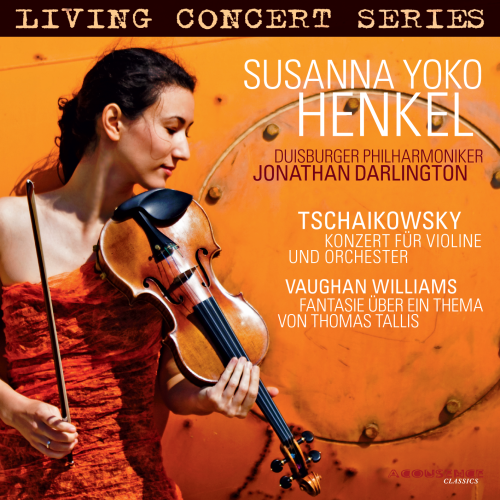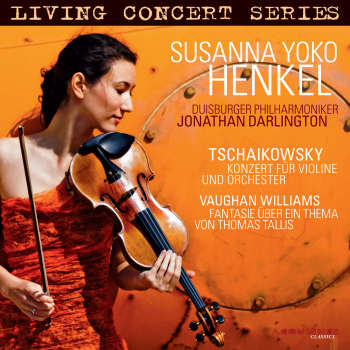
Tchaikovsky's Violin Concerto Susanna Yoko Henkel
Album info
Album-Release:
2010
HRA-Release:
13.10.2010
Label: ACOUSENCE
Genre: Classical
Subgenre: Orchestral
Artist: Susanna Yoko Henkel
Composer: Peter Ilyich Tchaikowsky, Ralph Vaughan Williams (1872-1958)
Album including Album cover Booklet (PDF)
- Peter Iljitsch Tschaikowsky (1840-1893): Konzert für Violine und Orchester D-Dur op. 35:
- 1 Tschaikowsky: Konzert für Violine und Orchester D-Dur op. 35: Allegro moderato 18:36
- 2 Tschaikowsky: Konzert für Violine und Orchester D-Dur op. 35: Canzonetta. Andante 06:10
- 3 Tschaikowsky: Konzert für Violine und Orchester D-Dur op. 35: Finale. Allegro vivacissimo 10:58
- Ralph Vaughan Williams (1872-1958): Fantasie:
- 4 Williams: Fantasie 16:01
Info for Tchaikovsky's Violin Concerto
Susanna Yoko Henkel belongs to the leading violinists of the young generation. The most recent recording combines the enchanting atmosphere of a live performance with a multi-faceted interpretation and skillful adaptation. One seldom hears such a subtle detailed presentation, along with a firm sense for the large musical arches. Energy and a terrific tone, paired with technical brilliance promise the highest possible listening pleasure.
Peter Ilyich Tchaikovsky: Concerto for Violin and Orchestra D major Op. 35
The Violin Concerto by Peter Ilyich Tchaikovsky is one of the truly great compositions for violin composed in the 19th century and is frequently mentioned in the same breath with the concertos by Ludwig van Beethoven (1806), Felix Mendelssohn Bartholdy (1845), Max Bruch (Concerto Nr. 1, 1868) and Johannes Brahms (1879). However, Tchaikovsky’s concerto differs from most of these in deliberately eschewing their solemnity and grandeur as it was the primary aspiration of the Russian to allow his musical concept itself to have a direct impact: ”It is music that flows from the depths of an artistic soul roused by inspiration that alone can touch, move and excite”.
Although written to cope with a personal crisis in the composer’s life, Tchaikovsky’s Violin Concerto is a life-affirming and optimistic work. It is popular with the musicloving public and performers have always found it be an extremely challenging work that requires them to master major technical difficulties.
Ralph Vaughan Williams: Fantasia on a Theme by Thomas Tallis for Double String Orchestra
The Tallis Fantasia by Ralph Vaughan Williams premiered on 6 September 1910 at the Three Choirs Festival in Gloucester. The piece, which Vaughan Williams went on to revise in 1913 and again in 1919, was one of the works through which the composer triggered his artistic breakthrough. The Tallis Fantasia not only creates a connection to the past by employing modal tonalities, but actually uses an original theme composed by Thomas Tallis. This is taken from the hymn ”Why fum’th in fight the Gentiles spite, in fury raging stout?” in the Archbishop Parker’s Psalter. The melody is in the Phrygian mode, and opens with an austere rigour but glides into the sort of variations encountered in old English folk tunes. These two aspects are especially representative for the preferences of the composer Ralph Vaughan Williams.
The Fantasia on a Theme by Thomas Tallis was written for strings only. This evokes thoughts of reduction and simplicity, but the multitude of voices takes this firmly out of question. Vaughan Williams himself designated the Fantasia as a work for ”double string orchestra”, but in fact this description still remains somewhat imprecise: There is a full-size string orchestra (orchestra I), whose parts quite often undergo subdivisions, as well as a separately placed small string orchestra (orchestra II), consisting only of two first violins, two second violins, two violas, two cellos and a double bass. Furthermore, there is an additional string quartet formed by members of the first desks of the large orchestra.
The different sizes of the orchestral groups result in fascinating variations in sound intensity, namely when extraordinary echo effects are produced. One section is introduced by a longer viola solo and this solo extends until a quartet is playing. On instances like this it also becomes apparent that Vaughan Williams was not merely attempting to emulate Renaissance models but that he created a piece of music very much at the height of its time. In addition to skilful melodic variation, there is also an enormous range of rhythmic opulence that is treated with exquisite subtlety. All this results in a composition full of atmospheric enchantment.
Susanna Yoko Henkel, Violine
Duisburger Philharmoniker
Jonathan Darlington
LIVING CONCERT SERIES Vol. 15, 24Bit Quad Sampling Ultra Definition Recording
Award:
German-japanese violinst Susanna Yoko Henkel is honoured with the ECHO Klassik award 2011 for her recording of the Tchaikovsky violin concerto (concerto recording of the year 19th century / violin). Susanna Yoko Henkel: 'I am absolutely thrilled about receiving the ECHO Klassik award 2011. A dream comes true - the ECHO Klassik as the most renowned award in classical music means a huge recognition for my artistic work.'
Susanna Yoko Henkel
belongs to the leading violinists of the young generation. In 2007, the German 'Welt am Sonntag' declared her to be one of Anne Sophie Mutter’s heiresses, the renowned US music journal 'Strings' featured her on the cover of its January 2007 issue, and her recordings were highly praised in the trade press.
Susanna Yoko Henkel was born into a German- Japanese musical family and began to play the violin at the age of two, receiving lessons from her mother. Later, she received instruction from Conrad von der Goltz. At the tender age of 12, she enrolled at the Academy of Music in Freiburg/Germany, where she became a young protégé of Prof. Rainer Kussmaul. Later, she spent five years completing her studies at the Munich Academy under the tutelage of Ana Chumachenco.
During her studies Susanna Yoko Henkel already won numerous prizes at international competitions, among them the 'Queen Elisabeth Competition' in Brussels, the 'Mozart Competition' in Salzburg and the 'Tibor Varga Competition' in Sion. In 1998 she placed first at the German Music Competition in Berlin, followed by a scholarship from the Dortmund Mozart Society and the 'Deutsche Stiftung Musikleben'.
Her discography includes the Complete Recordings of Johann Sebastian Bach’s Sonatas and Partitas for Solo Violin, the chamber music works of Maurice Ravel, Sergei Prokofjev and Richard Strauss, the solo works of Ysaye, Bartók and Isang Yun and duo works for violin and violoncello by Handel/Halvorsen, Eisler, Schulhoff and Kodály.
In addition to her career as a soloist Susanna Yoko Henkel is a passionate chamber musician. In 2006 she founded her own chamber music festival in Zagreb/Croatia. It is now well established as one of the country’s major cultural events and has been televised by Croatian public television HTV since 2007. Among her partners in chambermusic are Itamar Golan, Lauma Skride, Pavel and Maxim Rysanov at renowned music festivals such as the Ansbacher Bachwoche, the Ludwigsburger Schlossfestspiele, the Rheingau-Musik-Festival and the concerts in the Paris Chatelet. During the 2009/2010 season, Susanna Yoko Henkel is 'Artist in Residence' of the Duisburg Philharmonic and in this capacity will not only perform and record Tschaikovsky’s Violin Concerto, but also take part in several Chamber Music projects
and Youth events.
Duisburger Philharmoniker (Duisburg Philharmonic Orchestra)
In the 1930’s the Duisburg Philharmonic Orchestra found a music director of high international renown in Eugen Jochum, succeeded by his brother Georg Ludwig Jochum, who oversaw the difficult task of reconstructing the orchestra after the war and remained music director until 1970. A long period of artistic continuity is associated with the names of Miltiades Caridis, Lawrence Foster, Alexander Lazarew, and Bruno Weil. Since the jubilee season of 2002/2003, the British conductor Jonathan Darlington has guided the fortunes of the Duisburg Philharmonic Orchestra as its music director. He has since substantially moulded and refined the orchestra’s personality. The impressive list of past guest conductors features names such as Alberto Erede, Carlos Kleiber, and Horst Stein, as well as Christian Thielemann, Ton Koopmann, and Fabio Luisi. Over the years the Duisburg Philharmonic Orchestra has attracted on a regular basis such renowned soloists as the pianists Ferruccio Busoni, Vladimir Horowitz, Claudio Arrau, and Wilhelm Kempf, and the violinists Yehudi Menuhin, Henryk Szeryng, and Arthur Grumiaux. Today much sought after artists such as Bruno Leonardo Gelber, Anna Gourari, Frank Peter Zimmermann, Antoine Tamestit, and Claudio Bohorquez are welcome guests of the orchestra.
The Duisburg Philharmonic Orchestra has always been committed to performing and commissioning new works. In recent times featured composers have included Wolfgang Rihm, Mauricio Kagel, Krzysztof Meyer, Jörg Baur, and Manfred Trojahn. Jonathan Darlington has continued to build on this tradition by initiating important premieres, such as the world premiere of Mauricio Kagel’s orchestral work “Broken Chords” and the German premiere of Tan Dun’s symphony “Heaven-Earth-Mankind”. The Duisburg Philharmonic Orchestra’s success has been complemented by concert tours to the former Soviet Union, the Netherlands, Spain, Finland, Great Britain, Greece, and China.
For its 2009/2010 season, the Duisburg Philharmonic Orchestra has been honoured with the “Best Concert Programme” award by DMV (Deutscher Musikverleger-Verband e.V.).
Booklet for Tchaikovsky's Violin Concerto











